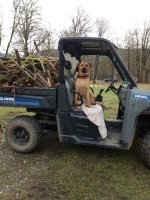DieselBound
Elite Member
Hills aren't kind to these things. They're pigs. I don't have real hills, only some slight inclines, and I can state that you're not going to traverse much over flat in anything other than low.
Put a bunch of stuff in the bed (or tow a load) and you'll have an excuse to go slow (and you'll forget the need to go faster). And pretend that you're retired (not in a hurry)!
Know what to expect:
2014 Ranger Diesel HST low top speed
I have a picture around of a crate of wood in the back of my Brutus (chainsaws and all the fixings from an outing cutting firewood). It was a load that no other UTV would likely have been able to handle (and move around on rough/uneven ground). I've also towed a ton (literally). They're mules, not race horses. HST is no different than on a tractor (as far as performance goes): at 24hp my Brutus IS faster than my 30hp Kubota HST B7800, and about the same as my Kioti NX5510.
I'd have never paid full price for mine. It was heavily discounted (NOS [New Old Stock]). Sitting for a long time (3 years) it resulted in a small leak from a seal that was compromised from sitting so long. Other than that issues (which I've accepted that I'll just ignore) I've only had to replace the front shocks (one was toast). Not bad for five years of some really hard use: no idea how many hours- haven't checked in a long time.
I don't use seatbelts; nor does my dog (so running fast isn't a good idea):
Put a bunch of stuff in the bed (or tow a load) and you'll have an excuse to go slow (and you'll forget the need to go faster). And pretend that you're retired (not in a hurry)!
Know what to expect:
2014 Ranger Diesel HST low top speed
I have a picture around of a crate of wood in the back of my Brutus (chainsaws and all the fixings from an outing cutting firewood). It was a load that no other UTV would likely have been able to handle (and move around on rough/uneven ground). I've also towed a ton (literally). They're mules, not race horses. HST is no different than on a tractor (as far as performance goes): at 24hp my Brutus IS faster than my 30hp Kubota HST B7800, and about the same as my Kioti NX5510.
I'd have never paid full price for mine. It was heavily discounted (NOS [New Old Stock]). Sitting for a long time (3 years) it resulted in a small leak from a seal that was compromised from sitting so long. Other than that issues (which I've accepted that I'll just ignore) I've only had to replace the front shocks (one was toast). Not bad for five years of some really hard use: no idea how many hours- haven't checked in a long time.
I don't use seatbelts; nor does my dog (so running fast isn't a good idea):
